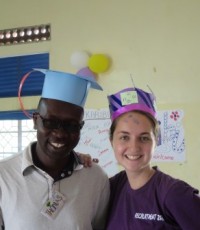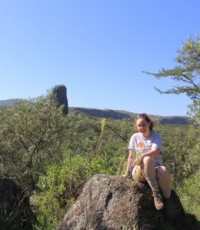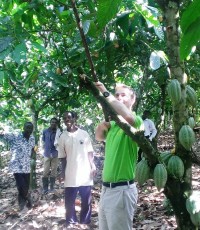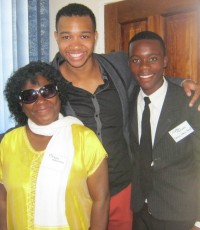March - April 2014
Dear Friends,
As this edition of the Fellows Flyer demonstrates, our Fellows are as busy as ever – whether it’s learning the ins and outs of the Ghanaian cocoa industry or offering technical assistance to communities in Burundi regarding safe water sources. Thankfully, from March 7 to 11, 42 of our Fellows got a welcome break from their hard work at PiAf’s mid-year retreat in Jinja, Uganda. These Fellows, along with a handful of PiAf staff, board members, and alumni, came together for a weekend of much-needed reflection, community, career development, and relaxation at the critical halfway point of their fellowships.
Meanwhile, here in Princeton, we’ve begun placing another incredible group of Fellows for our 2014-15 fellowship year. We look forward to finalizing these placements and introducing you to our new class of Fellows and partner organizations in the months ahead.
We hope you enjoy this edition of the Fellows Flyer!
Warm regards,
Stephanie Hooper Leroy
Acting Executive Director
(Executive Director Katie Henneman is currently on maternity leave. We wish her well and already miss her in the office!)
PiAf Connections
Please click below to check out pictures of our Fellows, Alums and other members of the PiAf family meeting up at home and around Africa.
Notes from the Field
By Sarah Evans, 2013-14 Fellow with Baylor International Pediatric AIDS Initiative in Tanzania
Though I studied Swahili for two years at the University of Pennsylvania before moving to Mwanza, Tanzania, I could not have been more wrong about which Swahili expressions would be the most useful. In my Fellows Flyer article, I’ve decided to take you through some of these new phrases and how they paint the most accurate picture of my life in Mwanza and work at Baylor International Pediatric AIDS Initiative.
1) “Baridi… kama barafu” – Cold… like ice. Before moving to Tanzania, I was unaware that many Tanzanians prefer their drinks room temperature… or even warm “joto.” If I want a cold soda or beer, I’ve learned that it’s important to specify not only that I want my drink cold; but that I want it really, really cold – like ice. Happy hour with co-workers on Monday would be impossible without this phrase.
2) “Kunywa dawa yako” – Drink your medicine. One of the highlights of my experience at BIPAI Tanzania has been spending time with patients. I never imagined that I would get to spend so much of my time interacting with people! Through chatting with caregivers, exploring difficult concepts with teens, or just playing games with kids, I have learned a whole host of Swahili medical vocabulary I never would have thought I needed to know. Though in English we “take” medication, in Swahili you “drink” your medicine – whether or not it is a liquid. I don’t know the last workday that has gone by where I haven’t asked someone “Umekunywa dawa vizuri?”
3) “Umenikuta” – I was here first (literally “you have found me here”). Getting used to the lack of an organized waiting process has been one of the greatest challenges I’ve faced in Tanzania. I never knew I could miss waiting in line so much. But, the mob scene at the bank or cafeteria has taught me assertive vocabulary and also facilitated some of the most hilarious conversations I’ve had here.
4) “Fanya mazoezi” – Do exercise. Mazoezi was one of those words I could never remember in class. I also dismissed it – how many times would I be talking to Tanzanians about my workout regimen? Little did I know that I would join in on P90X almost every day after work with my co-workers. Though sweating to P90X alongside my boss, driver, and finance manager in an office classroom was not how I pictured staying fit in Mwanza, “mazoezi” has become one of the highlights of my day.
5) “Kiti moto” – Literally “hot chair” but ACTUALLY one of the most delicious Tanzanian dishes out there. Whenever I get tired of rice and beans or chips mayai (an omelette made with French fries), I always head to Digital Bar or Shooters for my fix of Kiti moto. Named Kiti moto to avoid the stigma around eating pork in Tanzania, this delicious juicy pork stew (sold by the kilo) has gotten me through some of my toughest weeks in Mwanza.
6) “Matumaini” – Hope. Planning and working at Camp Matumaini, a weeklong sleepaway camp run by Baylor for Baylor patients ages 10-13 has been one of the highlights of my experience in TZ and probably of my life. I learned so much about hope and happiness from some of the coolest kids on the planet – and greatly improved my Swahili along the way!
Notes from the Field
By Maya Gainer, 2013-14 Fellow with International Rescue Committee in Kenya
After several months living in Nairobi as a Fellow at IRC-Kenya, I’ve had the chance to host some visitors, including Fellows from around the continent. To show those of you who haven’t made it to Nairobi yet the possibilities – and maybe tempt a few more to stop by – here’s my guide to a few of the best activities in and around the city.
+ The Nairobi National Park circuit: A must for animal lovers! The park is only 7 km away, making it the protected area closest to a capital city. Get up early to see the wildlife at its best – lions, rhinos and giraffes, all with a backdrop of skyscrapers. From there, stop by the Sheldrick Wildlife Trust to watch orphaned baby elephants drink from bottles and hear about how they will be reintroduced into the wild. Finally, head to the Giraffe Center to feed giraffes from your hand – or for those wanting to get up close and personal, your mouth.
+ Brunch: Not the first thing you might imagine, but all the more fun because of it. Nairobi boasts a surprisingly large number of brunch spots, all of which are fantastic. These cafés wouldn’t be out of place back home – but we all need a taste of home sometimes, especially in the form of phenomenal omelets and smoothies.
+ Ngong Hills: Just outside Nairobi, but an easy way to get your nature fix in a day trip. Take a bus from my neighborhood, Kilimani, to the end of the line in Ngong Town, and watch the bustle of the city give way to the green of the hills. From the base of the hills head up (and up and up!), take a left at the wind farm, and keep going up and down as far as your energy can take you. From the top, admire the views of Nairobi and the Rift Valley.
+ Visit the PRC: My favorite aspect of working with the IRC has been learning about urban refugee programming, which is run out of our Protection and Referral Center in Eastleigh. Although we usually picture vast camps (like Dadaab, which I also support), urban refugees now make up approximately half of the world’s refugee population. Take this opportunity to learn about the distinct security and economic challenges facing urban refugees, and how organizations like the IRC have adapted their programs to the urban context.
+ KICC: It sounds incredibly touristy, but a visit to the helipad on top of the Kenyatta International Conference Center is a quick way to get a sense of the many faces of Nairobi. From here, take in the bustle and traffic jams of the Central Business district, skyscrapers and embassies of Upper Hill, tin roofs of Kibera, and lush green of the Karen and Gigiri suburbs.
+ Beyond the city: Feeling a little more ambitious? Kenya has a lot more to offer, from biking next to giraffes and zebras in Hell’s Gate National Park to the pristine beaches along the coast. Take it from me – even with a year, it’s hard to do it all!
Notes from the Field
By Flannery McArdle, 2013-14 Fellow with Plan International in Uganda
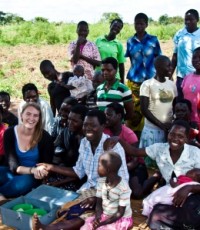
Flannery meets with young mothers participating in one of Plan Uganda’s Village Savings and Loan Associations.
A few times each month I am responsible for bringing donors, sponsors, journalists or Plan staff from other countries to visit projects. Consistently, their biggest critique of the visit is that the beneficiaries and field staff mention only the positives, as if this one project were responsible for eliminating all problems in the community. They want to hear the good things, but they also want to know about the obstacles and daily challenges that remain.
In an effort to practice what I preach, in reflecting over the past 6 months of my fellowship, I will not just share the positives, the reasons why I have come to love Uganda, but also the challenges and the frustrations, because I believe they are equally valuable. So, what have I gained? What have I lost?
I have lost the ability to sleep without my mosquito net.
I have shed my hatred of boda bodas (motorcycle taxis) and gained an appreciation for the wind in my hair and the satisfaction of weaving in between cars and on the sidewalk past kilometers and kilometers of traffic.
I have gained an appreciation of the high-energy and fun-loving nature of Kampala, evidenced by the spontaneous dance performances and the near-perpetual echo of laughter in the streets, restaurants, shops and halls of my office.
I have a newfound disdain for organized activities within a five-kilometer radius of my house (as they have a tendency to wake me up at 5am).
And roosters.
And people who play Rihanna at 4am.
And traffic.
I have gained an undying love for avocados.
And pineapples.
And manhole covers.
And paved roads.
And walking around town on Sunday afternoons listening to hymns from church choirs float above sparsely populated streets.
I have gained an appreciation for extended greetings that can last longer than the intended conversation.
I have lost a pair of jeans, some shorts, a shirt, a phone, a purse, $20.
I have gained an understanding of the complexity of poverty and have lost confidence in the traditional channels of development and aid to address it alone without the support of the government.
I have gained motivation and inspiration from my coworkers and beneficiaries and have a newfound hope both in the power and in the determination of people to help each other.
So, a lot has changed over the past 6 months, but I wouldn’t change a single minute of it – positive or negative – because no place is perfect, and no experience is without flaws. Great stories and lessons learned don’t just come from kayaking down the Nile and successfully finishing a big project at work, but also from challenging work assignments and roaming around town for 45 minutes with a boda driver who swore he knew where he was going.
Notes from the Field
By Caitlin Monroe, 2013-14 Fellow with Lutheran World Federation in Burundi
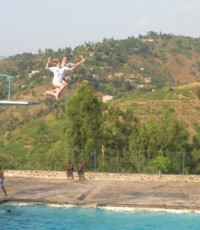
Caity (left) and ’12-’13 LWF Fellow Bjorn Whitmore at the campus pool of one of Bujumbura’s universities.
In what I’m told has been a Burundi PiAf Fellow tradition for several years, every time a visitor arrives in Bujumbura, we go for a drink on the shores of Lake Tanganyika. Once there, we sit on the dock, look at the lake and Congo’s gorgeous but often muted-by-dust mountains across the way, and order a drink. In a literary/overly analytical spin on this tradition, I have decided to introduce my life, job, and home country by dedicating my Fellows Flyer article to the most common beverages available in Burundi.
Water
Beyond the ever-present struggle of me remembering to drink enough water to stave off dehydration in Bujumbura’s heat, water is important to this story because one of my first field site visits was to a safe water source. LWF Burundi doesn’t do as many public construction activities as we do empowerment trainings and agriculture projects, but we do help communities we work with develop proposals for a water source and then help them to obtain the technical and financial resources necessary, while they help supply labor and maintenance efforts.
Beer
After Cankuzo field visits (where I do interviews and visit different community development projects), I often grab a beer and brochette with coworkers. Primus, which is also made in Rwanda and Congo, is one of two main beers in Burundi. My coworkers (and many others) claim that the Lake Tanganyika water makes Burundian Primus “far superior” to the Primus brewed at Rwandan and Congolese breweries (and Burundian singer Gael Faye claims it’s “the best Primus in all of Africa”). I’m not sure I can tell a difference, but I have learned a number of Kirundi vocabulary words to talk about beer (including the Kirundi saying warning people to never leave that last inch of beer in the bottle). Amstel, the other main beer, is originally a Dutch beer, but Burundi’s Brarudi now brews it domestically, using different combinations of ingredients, and the Lake Tanganyika water, for a different (and much better) result.
Speaking of beer, the Burundian president recently unveiled his own brand of beer. Though I think it tastes great, some Burundians scoff at the idea of drinking a beer that may tacitly lend support to President Nkurunziza and the CNDD-FDD, Burundi’s ruling party and the recent subject of several worrisome political forecasts.
Pineapple, mango, and passionfruit juice
I will probably never drink juice in the US again.
Fanta
Burundi has orange Fanta (gross) and lemon Fanta (delicious). A number of LWF rights-holders have participated in business and marketing trainings, and after needs and demands, many decide to open small kiosks selling Fanta and snacks as income-generating activities. Sometimes in Cankuzo you can also find pineapple Fanta from Tanzania. Cankuzo borders western Tanzania, and there’s a lot of evidence of this on the ground, including the presence of Swahili, Tanzanian products, and repatriated Burundians who spent the majority of Burundi’s recent civil war in Tanzanian refugee camps. LWF’s social cohesion projects originally targeted only repatriated refugees, which is why we are based where we are today.
Wine
Burundi, you have many amazing qualities, but unlike Oregon (my home state) and Napa (an hour from where I lived the past five years), great wine is not one of them. Missing wine (and the friends and family I drank it with) sometimes brings on pangs of homesickness, but like most things in Burundi, if you look hard enough you can find it. My current favorite Thursday night Bujumbura tradition is a wine bar with a great selection of wine and cheeses and a Thai restaurant just next door.
Notes from the Field
By Sophia Robele, 2013-14 Fellow with World Food Programme in South Africa
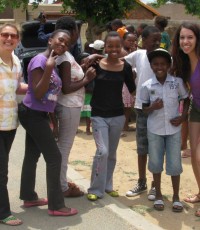
Sophia (far right) with members of a junior youth group she facilitates each week that focuses on Bahá’í principles and spiritual empowerment for kids aged 11-14.
On Valentine’s Day, a cheesy-but-cute construction paper “Wall of Love” was put up in my office for all UN staff in the building to write down what they love about their job.
I basically wrote a whole paragraph.
It was something along the lines of “I love working among so many diverse, passionate, and inspiring individuals. I love working for an institution that not only strives to build a more peaceful and just world, but one that does so through a truly global and collaborative effort – particularly in the context of a world where nationalistic interests often prevent real progress. Global problems can only be solved through unified global efforts.”
In having the chance to write down my appreciation on a wall, I realized that all my high expectations of my fellowship post had actually been met. Coming into my post at the UN World Food Programme’s regional bureau for southern Africa, based in Johannesburg, I had all these grand assumptions about the UN and its agencies. Particularly with my religious background as a Bahá’í – a religion whose main aim is essentially to unify mankind and which teaches that the underlying cause of all the world’s ills is disunity – I was excited to work for an institution that so perfectly seemed to embody my view of the world.
With expectations so high and ideal, a part of me also expected to have some of my preconceptions shattered once actually seeing the reality. Seven months into my fellowship, however, and I still have the utmost admiration for the efforts of my organization and the UN as a whole. It is all too common to find people who have worked in the humanitarian or development field for years, and have slowly become so jaded and critical from what they’ve seen that they eventually seem to no longer believe in the possibility of real change and progress.
As a Reports and Communications Assistant in the regional bureau, I’ve gotten a glimpse of all the different challenges faced by all of our 11 country offices, while also seeing the limitations created by bureaucratic processes and reliance on big government donors for funding. With my first real insight into such work, I was almost surprised to not fall into the same pattern of jadedness as so many others.
I think the main reason for my continued confidence in the work and achievements of the organization have come down to one thing, though: unity. When you have goals as lofty as “eliminating hunger in our lifetime,” the obstacles are immense. But when the goal is something that is completely attainable (it’s not like there’s not enough food in the world to feed everyone), then the only real thing standing in the way is a lack of commitment by everyone with the power to solve it.
Within the scope of WFP – of the global engagement by governments, NGO partners, and local communities – there is incredible potential for change. A certain degree of criticalness in the context of humanitarian aid and development is necessary, but increased global recognition that real progress is possible is equally vital.
Notes from the Field
By Daniel Robinson, 2013-14 Fellow with Olam International in Ghana
I have come to think of my location as both the best and worst parts of working in rural Ghana. On one hand, living in Sefwi Wiawso, Ghana is extraordinarily isolated. I have only met a handful of other expats outside of Accra, and the social activities have left a bit to be desired. However, living in Western Ghana has first and foremost been a remarkable experience, as being far from the city also allows me to be less than an hour from more than 5,000 of the cocoa farmers with whom Olam Ghana works.
On a daily basis, I have the opportunity to meet directly with cocoa farmers at their homes or on their farms, and in the process I have learned as much as I ever did in a college course. When I began my time in Ghana, I couldn’t have told you what a cocoa tree looked like (answer: cocoa is actually a colorful fruit). Eight months later, I am comfortable explaining the full cocoa supply chain ranging from how long to dry and ferment cocoa beans to how to prepare cocoa for the market.
Along with my day-to-day education on the cocoa industry, I have also learned something that work in the US never could have given me: an understanding of life in ‘the field.’ My greatest take-away from my time in Ghana has been a confirmation that it really isn’t possible to grasp the needs of farmers and their families unless you’ve been to see them in person. When I left the US, I had an idea of how things would be in rural Africa, but after working in Sefwi Wiawso, it is clear that no amount of words and captions can fully capture how rural agricultural programs work on the ground.
In addition to meeting with farmers, my work with Olam has focused on the process of obtaining and maintaining Rainforest Alliance cocoa certification. In particular, I have worked directly with RA on the world’s first ‘climate-friendly’ cocoa program. Along with the normal objectives of Rainforest Alliance certification, such as the use of good agricultural practices (GAP) and the prevention of child labor, the Olam/RA partnership in the Juabeso/Bia District features specially designed climate change prevention methods that limit the impact of cocoa farming on the environment. Ghana has had severe deforestation during the last few decades, but through programs such as this climate smart cocoa project, the government and many other organizations are working to make positive impacts on the environment and the livelihoods of farmers.
Outside the office, my life in Ghana has been a mix of literature (28 books and counting), music, European sporting events and occasional adventures around the country. My top three non-work memories from my time in Ghana are:
3. Crossing rope bridges among the trees at Kakum National Park
2. Having mona monkeys eat out of my hand at the Tafi Atome Monkey Sanctuary
1. Watching the Ghana “Black Stars” soccer team defeat Zambia to advance toward the World Cup
Notes from the Field
By Fritz Siegert, 2013-14 Fellow with Maru-a-Pula in Botswana
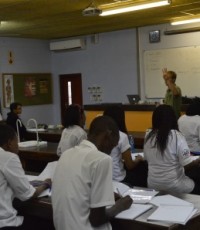
Fritz teaching his Form 3 Junior Science Class (8th/9th grade equivalent). “How many significant figures does the number 5481 have?” “Four!”
“I teach middle school science in Botswana.”
This is a phrase I have now had to reiterate to countless friends, family members, and new acquaintances for the over nine months I’ve lived and worked at Maru-a-Pula Secondary School in Gaborone, Botswana. Much like a new pair of shoes, this phrase took some wearing-in before it truly felt comfortable.
While I have stumbled through different lesson plans and science experiments that didn’t bubble or change color or catch fire like they were supposed to, my students have remained engaged and curious about the scientific world around them. I work at a great school, so defined by the school’s students, who are as ethnically, racially, and socioeconomically diverse as they are naturally intelligent and inquisitive.
Though the majority of my adult life has been devoted to academia in one way or another, I have never worked as a teacher before. And though I’ve taken classes on African history, read many books, listened to many songs, and seen many movies, I had never set foot on the African continent till I moved to Botswana for this fellowship.
And yet, in the middle of June 2013, I stood in front of my first class of 29 students as I taught them about the respiratory system. I have been learning ever since.
+ I have learned that often the best lessons require very little “teaching.” Rather, lesson time is better spent enabling students to teach themselves as they work together to solve different problems.
+ I have learned that a class responds to enthusiasm and energy. I find that my class is often most excited by the lessons that I myself am most excited about.
+ I have learned that the language of science can reach across cultural barriers. What do I know of the student who has spent his entire life in rural Botswana before being adopted and enrolled in MaP? Not much is the answer, but I do know that that same student’s eyes light up when you show him a YouTube video of an open-heart surgery to demonstrate the “pumping action” of the cardiovascular system.
+ And I have learned that no matter how bad of a day you may be having, receiving a note from your student thanking you for “curing my fear of science and test-taking” will always make your day better.
I love where I have lived and worked these past few months, and know that this is but the beginning of my relationship with Botswana and with Africa. I love how this is an environment where I am constantly learning as I try to teach. And with each lesson I have learned inside the classroom of MaP, exploring the city of Gaborone, or off adventuring in the surrounding villages (a favorite pastime), I grow more comfortable with and confident in stating the phrase,
“I teach middle school science in Botswana.”
Notes from the Field
By Gordon Taylor, 2013-14 Fellow with Kucetekela Foundation in Zambia
I can’t believe that seven months have passed since I landed in Zambia. Oh… how time flies when you are having fun. It seems like just yesterday I was in Princeton, New Jersey with about 50 strangers and we were discussing our future lives in Africa, and now I am navigating my way through Lusaka’s compounds and helping lead initiatives that are impacting the future leaders of Zambia. My first weeks were like a hurricane. I felt a little uncomfortable about some of the tough situations I faced early on in my PiAf fellowship, but now feel very comfortable with my surroundings and, most importantly, my work responsibilities.
My time in Lusaka has been filled with many adventurous journeys and I continue to seek out the new challenges in my new home. Currently, I work as the Program Coordinator for the Kucetekela Foundation after working for three years for Deloitte Consulting LLP. On the job, I have had the awesome opportunity to implement a program called the Leadership and Life Skills Summit, which is a program that allows gap year students to develop their maximum leadership and professional potential through modules, worksheets and volunteering at a professional entity to gain experience in the career area each student is interested in. The program teaches the students a sense of who they are and helps them define what they want to be in the future. The lessons range from passion pitches to brand recognition to career exploration. I have applied to different tertiary educational programs such as African Leadership Academy, MasterCard scholarships, Earth University, and the NESA exchange program for the Grade 12 and Gap Year students. It has been gratifying to see the development of the students when they go to the next level in their academic studies. The best part of working for the Kucetekela Foundation is seeing the kids grow up and achieve their goals and ambitions.
Aside from work, I have been able to experience and learn new things about myself. Below are some fun activities I have engaged in since arriving in Lusaka:
- Playing squash with new friends
- Attending salsa classes and going to the salsa nights at Rhapsody
- Coaching the American School Boys basketball team
- Working out with my personal trainer Thomas Mutembo
- Hooping as the starting point guard for the UNZA pacers
- Visiting the elephant orphanage at Lilyai Lounge
- Swimming in this secret Lusaka lake called “Monkey Pools”
- Randomly traveling to Ndola to hang out with my ZEHRP friends





